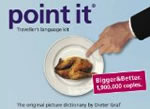You'll be relying on intuition for most of your journey, but it is always nice to take along a few extra hints from those who have previously traipsed down the same travel path. Here you'll find is a selection of cycle and not so cycle travel tips associated more with everyday life. From transport and travel issues like dealing with airports; hotel and bike security; to ways of travelling responsibly and getting a bit closer and wiser to local culture. There is bound to be one or two of the following travel tricks that you could use the next time you embark on your travel journey.
COMMUNICATION & ELECTRONICS
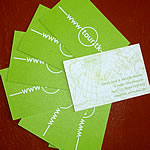

if you promise to send
a copy
of a photograph,
then please make sure
you do it.

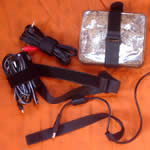
velcrose straps keep
your
electrical cords
neat and tidy
A handy little memento
Having business cards printed with your email, website or blog information is
definitely a growing trend among travellers these days. And here's why:
easierthan writing your details down a million times on bits of paper, only to be lost
in trouser pockets
people tend to put a business card in a safe spot somewhere
no misinterpretation of handwriting or email addresses
impressive introduction to hotel owners and businesses
you meet on your travels
if you make them unique, you'll be remembered
And it is not necessary to go to all the trouble of getting them professionally made and then carting them around with you. A simple layout on an A4 sheet of paper can be easily printed off in an internet cafe; cut up and dealt out as required. As soon as you need more, just print another page or two off.
Self addressed stickers
On the road, you often get the chance to
snap a shot of a local. Not only do they
often get a kick out of seeing the result
on the camera screen, but they want a copy
too. Living in the western world
means access to email addresses and internet,
so sending a photograph is not really a
big hassle. People from poorer countries
don't always have this privilege and it is a little more effort to get a
photograph to them.
Since we always appreciate it - when people forward on pictures they take of us - we try our very best to do the same. The biggest problem that arose was not printing off the photograph and posting it, but trying to read or copy the address they had written down for us, especially if it was in another script.
So now, instead of writing it down on any old bit of paper, we give them a white sticker or blank square of paper so they can write it down themselves. Just glue or stick the address on the envelope and pop it in the mail. They really will appreciate receiving it.
Shining
a new light on your digital
pocket camera
Our little pocket camera is one of the
most useful items in our electronic gear.
Not only do we use it for taking pictures,
but also for a wide range
of other tasks:
A
handy way of storing and accessing maps
for use while cycle touring or entering
towns.
Saves
carrying the guide book with you. Copy
the town map; list of restaurants; attractions
you want to see.
Take
a snap of an information or address plaque,
street sign or place that you visited for
future reference.
Keep
a copy of useful or official documents
with you.
Have
family or home photographs ready to show
others.
Taking
a series of snaps at memorable points during
the day to help you remember when writing
up your blog
If
the language is difficult or in a different
script, take photographs of signs, addresses
or even your hotel to show to a taxi driver.
Have
a permanent bright sky shot at the beginning
to use as a back-up light.
In the Vagabondish Travel Tip article: 12 Clever Uses for Your Digital Camera, Mike Richards explains that you can add a bit of camera safeguard by taking a picture of a marker-pen written reward flyer, stating your name, email address and possibly a reward as well. Lock the file and should your camera be lost, there is a chance that an honest citizen might return it to you.
Mike goes even further to say that your digital camera can help you when renting a car and become a mirror too. Talk about a multi-functioning piece of kit. Definitely stays on our touring pack-list. Take a look at the article if you want to find out more.
Handy velcrose straps
Whatever you call it: velcrose, rip-zip,
or hook & loop, this haberdashery item
is useful in many impromptu and permanent
situations. We always have a supply of
it in the sewing kit.
Most electrical cords come with a handy strap these days, but if they don't, it is easy enough to make your own. Not only this, but a strap can hold tins tight or be a temporary fastener if one of your bag buckles breaks. Some people even use these straps to tie their brake handles to the handle bar when parking their bike on a hill.
One small problem that could arise, is when either the hook or the loop side gets clogged up with grass, hair, or dirt. An effective way to clean this is with duct tape. Rip of a piece, place it over the velcrose strip, rub slightly and pull off. All dirt on the strap will now be stuck to the tape.
While it is not possible to learn the language of every country you visit - especially if your trip is going to be short - you can at least make the effort to say a couple of important words: hello, thank you and please are the first three that spring to mind. And then there are the words associated with eating and drinking. Locals really appreciate foreigners making an effort, no matter how small. If you tell the chef in the kitchen his meal is "delicious" then you will be loved forever and probably given an extra helping next time round.
They love it too, if you know something about their country, so do a bit of general knowledge research before you leave. Guaranteed, if you come from the western world, they'll know quite a bit about your country of origin.
Carry
a little dictionary along for the ride
We have had some of the most memorable conversations
with the use of a dual language dictionary.
Not only can you look up words to explain
yourself, but the person you are speaking
to can too. One of the classic examples I
still remember was in Thailand. The conversation
had come to a halt. Ali had tried, I had tried;
we just couldn't pronounce and explain what
we wanted to say. The man we were talking
with didn't understand a thing and it was
quite frustrating. So, in an action to lighten
up the mood, Ali flipped open the dictionary
on a random page and read the first line
that caught his attention: "Would
you like this dance with me?" The whole table burst out
laughing. He had said it
perfectly and it was a cracking
icebreaker.
The other excellent travel communication book is Point It: a passport sized picture dictionary by Dieter Graf. Not much extra baggage at 8.9 x 12.7 cm and only 45 grams. Now, everyone in the world will be able to understand you.
- Celine Roque's complete guide to self studying a foreign language
- Go Green Travel Green article by Kimberley: 9 tips for learning a language in a foreign country
- 7 tips for learning a foreign language on the road: Tim Patterson's wise words of experience
- How to say hello in different languages
CUSTOMS
"Is tipping customary?" : one of the many cultural questions that pops into a travellers' mind when stepping from one country to the next.
While it is commonplace in the US,
it is not necessarily the norm in other
countries. For example in Mexico and Central
America, it is usual to tip the kids bagging
your groceries, whereas in Korea and Japan
it is considered rude to leave a tip behind
in eating and drinking establishments.
In fact, you'll have the waitperson running
after you to give you your change back.
The best advice would be to
do some homework before you leave home.
There are a multitude of country info websites
out there to peruse for this sort of information.
One such site is worldtravelguide,
but cross referencing is always a good
idea. Another way of knowing what the
custom is, is to watch locals closely when
it comes to paying in a restaurant or supermarket.
It's not that hard to work out what is
going on through body language and gestures.
See our money
tips for more
tips on handling your money while travelling.
Country
specific tipping customs can be found on
our individual country
information pages.
How to handle hassling
salesmen!
Ali cleverly devised this 'one liner' that worked
a treat for us in Turkey. The carpet salesmen quite often use the attention getter: You
come from Australia? - or whatever country they think of at the time. it
is just a ploy to start up a conversation and then invite you into their
shop. The only problem is they don't give up and end up following you down the
street running through every western country of the world.
In order to stop this: turn around and direct the same question back at them: "You come from Turkey?" It either stops them dead; or they start laughing giving you a few seconds and enough time to walk out of hearing distance.
Sharpening those bartering skillsYou are either good at it or you are not. Whatever the case, remember that bargaining is just as much about socialising with locals as it is about saving money. So enjoy yourself while you are doing it.
Here's
a couple of tips to help keep the price
down:
Bargain
in local currency.
Know
your market so you don't: accept the first
price; or contrastingly, think you are
being ripped off when you are not. Ask
another local what something costs if you
really want to know local prices.
Stick
to your guns and don't be afraid to walk
away.
Don't
be too proud to come back.
Remember
that bargaining takes time.
Have
a variety of notes and change on you.
Don't
purchase form the obvious tourist stores,
move further a field.
Respect
economic differences: if you think its
a good price, pay it. Don't haggle
just for the sake of haggling.
Time
permitting, make yourself known to the
shop owner before purchasing from their
store.
Keep
smiling, it is supposed to be fun.
More money tips on our money tips and tricks page.
Thanking
locals
During your travels you will
be amazed at how many people will come
to your aid and help you out of a
sticky situation, share some important
knowledge with you or welcome you with open arms into their home.
You can of course, leave with heartfelt thank you's and gratitude hugs. That is okay, but you can also leave behind a little trinket from home. While you might think the koala fridge magnet or the Dutch clog key ring is tacky and unoriginal, people on the other end of the world really do enjoy receiving these little gifts.
The postcard decides
This tip was given to us from John
and Linda, a couple of perpetual travellers
like ourselves. They claim that
postcards can actually help you decide
which of the main attractions
you should visit and which ones you can
give a miss.
The logic behind this is as follows: if you have limited time and can't visit everything or you are simply in two minds about visiting a particular museum or tourist feature, then head to the nearest postcard rack and check out what is on offer. They usually have the best features on display and this way you can get an overview of all the main drawcards in town. From here you can choose which you might like to see.
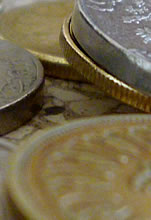
how much
should I really tip?

watch out for those
carpet salesmen
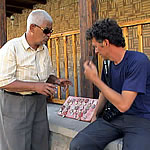
bartering is a fun way
to socialise with locals
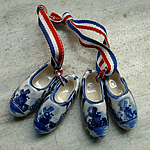
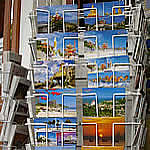
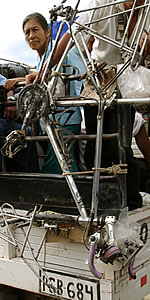
locals knew exactly
the best way to strap
the bike to the pick-up
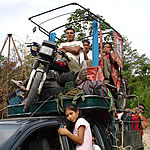
when locals put a
motor-taxi on top
of a taxi
we knew the road was
going to be bad
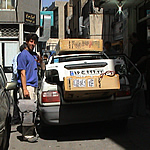
bikes boxed ready
for the airport
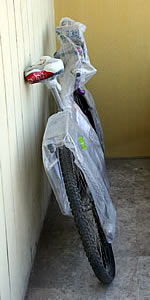
bike bubble-wrapped
for flying
Letting someone else steer the bike
There will be times when you are faced with the decision of whether to put your bicycle on some other form of transport. Often it will be out of necessity, but occasionally you want the luxoury of getting to another destination fast.Touring cyclists have been known to use all kinds of transport and for all types of reasons: visas running out and the country is too big to bicycle from border to border; an ocean or river gets in the way, the weather and wind change making it too dangerous or impossible to cycle; injuries; or just because they don't fancy pedalling a particular stretch. The latter doesn't really happen very often, because the general consensus is: if a cyclist can pedal it, then that's what they would rather do.
The reason for this is the hassle involved with taking another mode of transport other than pedalling the loaded bicycle yourself. And in our experience we’d prefer putting our bikes on, in order of preference: ferries, boats, trucks, pick-up cars, buses or trains and coming in last by a very large margin – for both annoyance and environmental reasons: the airplane.
Dealing with airports: the fight for your bikeI don’t have aviophobia, but I certainly hate flying when I'm on a cycling holiday and the dread normally begins from the moment we book the flight. After flying nine times with a loaded bicycle you think I'd be used to it, but unfortunately, there is no one standard and each airline (and sometimes even airport) has its own method of handling this situation.
Firstly, with such a diverse array of check-in baggage regulations and ambiguous wording of exactly how you must pack your bike, problems can arise. And believe me they nearly always do. Not one of the nine check-in experiences has ever been the same. Lastly, and this is the most frustrating, you will probably find that you are more knowledgeable about airline baggage policies than the airport staff behind the counter.
At this
point just smile
There are virtually no flight companies these
days that accept a bike without some sort
of protection and this is more about ensuring
that fellow passengers’ luggage is
not stained with grease or damaged by your
bicycle. And I can see their point. The problems
usually arise when your chosen method of
packing doesn’t appear to be the check-in
staff's idea of company policy - even
though you read the terms and conditions
thoroughly, sent off numerous emails and
received confirmation that your packing concept
was fine for flight carriage.
Heed the advice below and you will be armed
with the best ammunition to fight for your
bike.
At this point stick
to your guns
We need to rewind a little to the moment
just before you booked your flight. You haven’t
clicked on any confirm buttons yet and you
are reading the airline’s company wording
very carefully to see what conditions apply
for taking your bike on board. You have weighed
up cheap flight costs versus excess baggage
fees and are satisfied with your decision.
You hit “book flight”, not forgetting
to fill in special equipment fields mentioning
that you will be flying with a bicycle. Though
not usual these days, if there isn’t
a place for this information, send a separate
e-mail to the customer service outlining your
flight details etc. Okay, now for the really important part:
- printout a copy of your flight confirmation details;
- make copies of all e-mail correspondence regarding bike packing terms;
- if you telephone the company, write down the name, position or department of the person you spoke to.
- printout the terms and conditions of special baggage allowance; specific packing instructions
- printout excess baggage conditions and costs involved
- make sure all documents have dates & times on them: every bit of evidence is vital for the day
If you have flown with a bicycle more than once in your life, you will realise that there is no one set of rules out there: it is completely dependent on individual airline regulations. While most flights require you to turn your handlebars level with the frame; remove pedals and deflate your tires, the exact packing specifications is as varied as the world you are travelling in. Here’s a couple of prime examples:
British
Airways: We will accept non-motorised
bicycles of all dimensions provided they
are packed in a recognised
bicycle bag
Qantas:
To be accepted for carriage,
bicycles must be suitably
packed in a bike
box
Delta
Airlines: Your bike
must be packaged in a cardboard
or canvas container in
one of the following
ways: handlebars fixed
sideways and pedals removed
or handlebars and pedals
encased in plastic, styrofoam
or other similar material
Ryan
Air: Bicycles MUST
be contained in a protective
box or bag
EasyJet:The bicycle must
be packaged in a bicycle
box or bag
Air
France: Place
your bicycle in a protective
container (cardboard,
hard plastic)
Scandinavian
Airlines: We
recommend that you
pack your bicycle
in a bicycle
bag
Air
China: Regardless
of the actual size,
the following objects
can be treated as
luggage if total
length of three sides
is less than 158cm.
All checked baggage
must be properly
packaged,
have the ability
to sustain a certain
pressure, and can
be safely loaded
and transported under
normal operations.
Checked baggage may
not be placed in
a plastic bag.
The guidelines from all the above airlines are pretty easy to follow, except there is one ambiguous factor: “what exactly is a protective or recognised bicycle bag”?
| poly plastic bag | bubble wrap | cardboard | bike box | bike bag | bike suitcase | |
| ? | mattress shop purchase at CTC * |
post offices office supply stores |
refrigerator boxes strong fruit boxes |
airport bike store |
bike store online shop |
bike store online shop |
+ |
cheap & lightweight easily sourced take with you on tour use as ground sheet good rain protector baggage handlers can see what it is |
lightweight medium protection baggage handlers can see what it is |
good protection recyclable unusually shaped article & stands out |
recyclable cheap if sourced from bike shop |
purpose made fits range of bikes very good protection can fit in pannier no airport hassles |
purpose made best protection no airport hassles easy to carry |
- |
not all airlines think ·this good protection can leave your bike vulnerable to damage able to ride to airport |
takes time to pack not eco-friendly able to ride to airport |
heavy & adds to baggage weight baggage handlers can't see what it is difficult to transport to airport |
heavy & adds to baggage weight baggage handlers can't see what it is standard box difficult to transport to airport very expensive to purchase at airports |
takes up a lot of pannier space awkward & heavy to carry around able to ride to airport |
expensive size specific bike must be pulled apart or folded problem of storing when cycling unless it becomes a trailer |
* CTC has a letterhead document to download certifying their poly bag as a "purpose made bicycle bag. It looks very professional and official and could help you out when trying this method of packing. Don't forget to take it along with all your other documents.
Tried and tested
We
have both tried all of the above
except the purpose-made bike bag
and suitcase.
On
this tour we
have bubble
wrapped our
bikes on
three occasions:
it was successful
twice.
There
have never
had any
hassles regarding
how we packed
our bikes
every time
we used
a bike box.
The poly
bag experience was
part of
my first
cycle tour
and it
put me
off from
ever trying
it again.
That said,
other cyclists
have succeeded.
And it's
possible
that CTC's
document could
help you
out here.
At
this point you need to make
a decision.
Whatever the terms and conditions
are, whichever packing method you
decide on and however well you follow
the guidelines, there is still a
chance the situation at the check-in
desk will not go as you expected.
While problems do arise, sometimes
it can work out to your advantage
as well:
Cycling friends of ours, Lynne and Dave told us about their positive experience: "We flew from London to Caracas, Venezuela with TAP and their website clearly stated that we would incur a €100 fee for the bikes, but the check-in staff didn't ask for anything. I'd like to say they were being kind, but actually I don't think they understood the policy."
Our own Air Canada experience is quite a long story and at the time a process involving two long hours of negotiations too. We had bubble wrapped all delicate and oily parts prior to arriving at the check-in counter, so our bikes looked very respectable. But airline staff refused to let us fly without putting them in a box, even though their policy wording clearly said they would provide plastic bags for us at check-in. Bicycle boxing at the airport would cost $US70. Because we were armed with our paperwork and prior knowledge of their policy, they waivered the $50 handling fees for each bike and we paid for getting the bikes boxed. So, we actually ended up with $30 in our pockets. But it wasn't easy and we did have to fight hard for it.
At this point you are almost ready for lift off, but first a few more tips...Packing the bike
Put
your tools into your check-in luggage once
finished with disassembling your bike. Don't forget
to do this because it is almost impossible to get
metal objects through security and onto the plane
these days.
Try
loosening
your
pedals
the
day
before leaving
or
packing
your
bike.
After
long
months
of
cycling
in
the
elements
they
can
be
difficult
to
remove.
On
one
occasion
we
needed
to
visit
a
mechanic
to
release
them. Place
pedals
and
loose
parts
in
a
plastic
bag and
tape
to
your
frame
or
handlebar.
Never
leave
anything
loose
lying
in
your
box
or
bag.
Secure
pumps, bottles and
helmet to frame or
cages or remove them
altogether.
Remove
spindles from wheels if
they poke out too far,
or alternatively place
a thick piece of polystyrene
foam against them.
This can be found at
fresh fruit markets
or from electronic
packaging. Similarly
a few extra layers
of cardboard wedged
in tight can also help.
Pad
or remove your back
light.
Securing
a bolt between
front and back dropouts
can reduce the chance
of bent forks. I often
pack mattresses, sleeping
bags or foam around
this area. Bungy
cords help secure
these in position on
the frame
Clothes
bundled up in plastic
bags also make
good padding. Foam
pipe lagging is
very useful too.
Place
a layer of cardboard around
the contents when using
a really soft bike
bag for flight protection.
Take
extra packing tape incase
airline security wants
to check inside the
box.
Zip
ties are handy to
hold cables, chains
& derailleurs in
place, especially when
back wheel is removed.
Packing the
pannier bags
Exactly
how many
bags you
can take
on board
depends
on the
airline.
In any
case, most
will not
let you
tie small
bags together
with string
or bungy
cords.
This is
not good
news for
the fully
loaded
cyclist,
since you've
got at
least 3-4
panniers
and more
than likely
a dry sack
too. Airlines
don't mind however,
if you
put more
than one
bag in
a bigger
bag. The plastic
woven shopping
bags with
zips commonly
found in
Asia or
Chinatown markets
are perfect
for this.
They come
in all
sorts of
sizes and
are roomy
enough
to get
quite a
few pannier
bags in.
I still
recommend
strapping
these together
with bungy
cords so
the contents
are blocked
together
and don't
move around
too. Especially if the bag gets damaged. Meredith
and Keith got
two super
large bags
sewn together to make
a custom
bike bag for
their travels.
Draw
pictures,
smiley
faces, stick
figures
and
funny
text
on
A4
sheets
- coloured
paper
is
even
better
and
plaster
all
over
your
cardboard
box
or
plastic
wrapped
bike.
Make
it
look
really
different
from
any
normal
piece
of
luggage.
Some
of
the
lines
we
use
are:"Please
look
after
me,
I have
to
cycle
around
the
world"; "This
is
my
only
bike,
please
handle
with
care" and "World
cyclist" with
our
website
address. Whether
this
works
or
not,
I have
no
idea,
but
it
makes
us
feel
we
have
done
all
we
can
to
protect
our
bikes.
The
rest
is
in
the
hands
of
the
luggage
department.
So
far,
we
have
never
had
any
problems
with
damage.
Dealing with
check-in staff
Get
to the
airport
early.
This safeguards
that there
is enough
problem
solving
time, but
staff also
tend to
be more
cheerful
earlier
on in the
check-in
process
and hopefully
more generous
too.
Smile A LOT.
Feign
surprise when
they tell you how much your excess
luggage bill will be.
Ask
for a discount,
especially if you
are on a long term
tour. Tell them you
are cycling around
the world and plead
with them. If they
say they can't do
anything, ask to
speak to the manager
- this has worked
in our favour a couple
of times. Knocking
off a couple of hundred
dollars in excess
baggage charges is worth
a bit of play acting. If
you are cycling as
a couple, do the good
guy, bad guy scene.
And finally, if you
don't seem to be
getting anywhere, try bursting
into tears.
Loading
your pockets with
small electronic gear
and batteries; hanging
cameras around your
neck; slinging a small
bag underneath the
coat you are wearing;
as well as tying your
jumpers around your
hips will really reduce
your luggage weight
considerably. When
some airlines charge
$20 per kilo that you
are over, it is worth
the funny walk and
trouser hitching. Just
make sure you bring
a plastic shopping
bag with you to put
everything in once
you get past security.
A
bike box is generally
too big for
the weigh-in conveyor
belt, so you need to
assist by holding on
to it when it is being
weighed. By lifting
it ever so slightly
- without letting airline
staff see what you
do- you can get 5-6
kilos off the total
weight quite easily.
Breathe a sigh of relief when this process is all over. Shuffle your way towards the departure gates and airport security, removing all the electronic goods and batteries in your pockets before going through the metal detector. Put all this gear back into the plastic bag you brought along for this purpose and proceed through to immigration control. Walk a little easier through to the departure lounge. Don't look out the window to try and see if they are handling your bike with the TLC you would expect. Wait for the boarding call and enter airplane.
At this point you can sit back and enjoy your flight...
Links to airline sport or special equipment policiesSome airline companies have different rules and regulations depending on where you are travelling from and to, so it will pay to cross check these references by returning to the home page and filling in your departure region. It is sometimes difficult to find baggage specifications, but if you go directly to their sitemap you can generally spot the page link.
Air Arabia | Air Berlin | Air Canada | Air China | Air France | Aires | American Airlines | British Airways | Cathay Pacific | Condor | Continental Airlines | Delta Airlines | EasyJet | Egypt Air | Gulf Air | Iberia | Icelandic Air | JAL International 01 | JAL International 02 | Jet Star | KLM | Korean Air | Lufthansa | Qantas | Ryan Air | Scandinavian Airlines | Singapore Airlines | South African Airways | Southwest Airlines | TAP Portugal | Tiger Airways | UAE | United Airlines | US Airways |
Resources
A
great taking
bicycles on planes article from the Cycletourer.co.uk website by Frank and Jon.
Agenzel.com just
for the ingenious way to cart a bike box on your back
picture (hope for no wind): scroll down half way on
the page.
CTC
website:
UK’s
National
Cyclists’ Organisation
has some
great tips
for packing
a bike ready
for a flight.
They also
came up with
the CTC
Poly Bike
Bag available
from their
Wiggle.co.uk
shop. Coupled
with the letterhead
document describing
the poly
bag as an
official “purpose-made
bicycle bag”,
you might
just safe-sure
your bikes
carriage
with this
choice of
packing method.
CTC also has a very extensive information sheet: Taking
a Cycle by Air [word
doc 294KB]
Ibike.org has
a number of useful links and tips
here
Travel
with Bicycles:
a personal, non-commercial
attempt to collect
the experiences of
bicycle tourists who
use alternative transport
on their tour. Either
airlines, trains, buses
or ferries: an excellent
source of first hand
bike transport stories
Bike bags and suitcases
Chain
Reaction Cycles complete
bike & wheels
bag: this bag is really
sturdy stuff with separate
wheel compartments. Gets
two thumbs up for protection,
but at 6.2 kg and nearly
1.3 metres long, it isn't
really the bag to take
touring with you. Maybe
for a round circuit journey,
where you can leave the
bag behind and pick up
when you have finished
cycling.
Groundeffects TAR Bag: is one of the most lightweight bike bags on the market at 1.45 kg. And even though it takes up precious pannier space, it folds up into a neat A4 package. Definitely worthwhile thinking about according to Lynne and Dave, who used them on a recent journey through South and Central America.
A Serfas Bike Transport Case or the Trico Iron Bike Travel Case: highly recommended at Amazon
Foldable
bikes
If you feel like trading in all the
airport and transport hassles, the
following foldable bikes are the
most reputable on the market. They
can all be adapted for touring and
companies are quite willing to help
you out here.
Dahon
Folding Bike:
here's a real review from a Bike Friday owner
on the Dahon Speed TR
Brompton:
Another world reputable foldable
and Heinz Stücke's choice at the moment. Coupled with an axle mounted trailer such
as Radical Design’s Cyclone III, you are set.
Bike
Friday:
probably one of the most respected foldable bicycle tourers
on the market. It's good in action!
Airnimal:
very, very funky designs and makers are also committed
to helping touring cyclists.
But, if you really want to see something quite amazing as far as foldability is concerned take a look at this Inhabitat article: pretty gorgeous looking bike, but probably well out of most touring cyclists' price range. And those wheels? Well, I'm not sure they are quite up to a Taldyk pass adventure just yet... But a nice idea nevertheless.
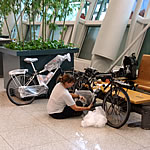
packing up the bikes
in
bubble wrap at Incheon
airport, South Korea
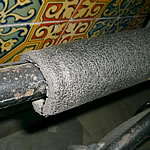
foam lagging is a great
way to protect frames,
derailleurs and other
vulnerable bike parts
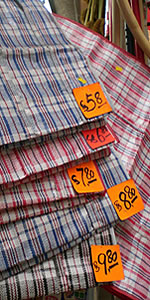
plastic Asian market bags
are perfect for putting your
panniers in by 紅白藍膠袋
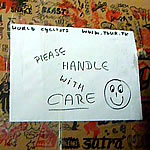
handle with care signs help
your bike box be noticed
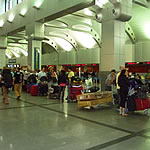
get to the airport early,
not just to avoid queues,
but check-in staff are
usually more generous
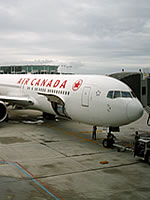
each airline has its own
set of rules regarding
bicycle carriage
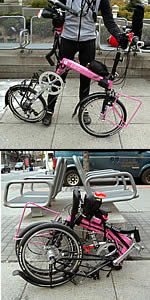
folding the Bike Friday
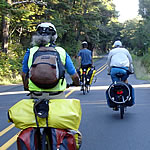
on the right,
a fully loaded Bike Friday
in action
Something other than air
Cycle touring is slow travel at its best. Not only is it a healthy way to immerse yourself directly in your surroundings, but it markedly reduces your carbon footprint too. And since one return flight from London to New York can produce about as much climate effect as a year of driving in an average European car, if you can choose another method of transporting yourself from A to B, then it is an eco-friendlier idea.
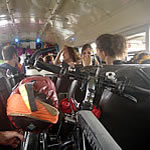
an unusual moment in
Panama when the bikes
were pushed in the back
end of the
bus
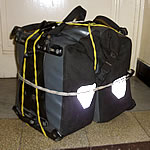
bungy cords or elastic
washing lines
are perfect
for securing your
panniers
together
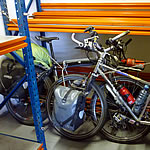
again, bungy cords are
perfect for securing your
bikes when transporting
them on ferries
While this would be our next least favourite mode of transport, it is (usually) hassle free. Even so, when purchasing or booking your ticket, it always pays to check just what the rules and regulations are regarding packing your bicycles and whether they are in fact even allowed on board. Some companies require boxing, some don't. There are also quirky details to think about. Though you'll probably never be asked to show them: travelling in Brazil, Argentina and other Latin American countries with a bicycle requires you to be in possession of a document certifying that you are the owner. We travel with a photocopy of our bicycle receipts in with our documents.
Bungy cords or elastic washing lines are great for strapping a couple of pannier bags together. Theft on buses throughout the world is a problem. If you bind your bike bags, it is more difficult for thieves to open them up in the first place and secondly, leaving no straps accessible makes them awkward, much heavier and therefore more difficult to run off with.
Sailing the seven seas
With ferries and boats you can breathe easy.
Quite often you just wheel or ride your loaded
bicycle on. Sea fishing and smaller river
boats sometimes require a bit of muscle lifting
them up and into place, but in all, this
mode of transport is by far the most cycle-friendly.
It is usually the most interesting too. So don't let a river ever stop you. Bungy cords come in handy on the waterways as well. They hold everything securely to rails and poles and wrapped around your panniers add a bit of extra security too.
Bike in the back of
a truck
For all sorts of reasons, we have used taxi's
and trucks. Often an impromptu moment when
wind and weather became too unbearable or
just too dangerous to continue. Occasionally,
it was a conscious decision. At these times,
prices were always negotiated prior to departure
and we played an active role in deciding
how our bicycles would be transported.
All by my bike
Obviously riding a loaded bicycle is our
preferred way of getting around and it is
by far the most eco friendly. But this is not the only reason to load up
the panniers and get pedalling. There is
a big, wide, wonderful world out there to
discover and at the same time, you might learn a bit about yourself too.
Need some relevant information
about travelling on transport modes other
that cycling?
Travel
with Bicycles: first
hand cycle touring experiences
using airlines, trains,
buses and ferries
Post
a message on one of the forums:
Lonely
Planet | Bike
Forums | Cycle
chat | CTC | CycloCamping | Wereldfietser (Dutch)
How
much impact do you have
on the environment?
greenprogress.com:
a carbon footprint calculator
train
versus plane: a few
staggering facts
Although I love the ocean, boats have never really been my thing. But unless I tried to read something whilst on the move, other forms of transport were not problematic. Lots of people have an issue with that, so it never really worried me.
These days however - and it boils down to the last four years of virtually only using a bicycle as a mode of transport - I get motion sickness at the slightest bend in the road and on any form of motorised vehicle. Especially so, if the driver is anything like the chauffeur that took us to the top of Corcovado mountain to see Cristo Redentor in Rio De Janeiro.
So what do I do about it?Well there are three methods up my sleeve, depending on the length and type of journey. And since everyone reacts differently I'll describe these on a 'likelihood to suffer from motion sickness' scale.
LOW - short
ferry trips and local transport
from A to B
Cross my hands and
hold my thumbs on the Nei-Kuan-acupuncture
point. You can find this
by placing your three middle
fingers on your inside wrist
like searching for a pulse.
Under your index finger you
will locate a small hollow
between the tendons: this
is your nausea prevention
point. By adding pressure
to it during travel, you
can prevent suffering from
motion sickness. A step up
from this DIY method is to
purchase some specially designed
bands. They work on exactly
the same principle and save
you from looking like you
are using a special form
of meditation.
MEDIUM - a
few hours to a day ferry trip; long bus/car
journeys
The next course of
action involves using the
above method and the intake
of ginger. The best products
I have found are chewing
gum, tea or boiled sweets.
But any thing with ginger
in it will do and it really
does work with calming the
stomach and relieving nausea
symptoms. Ingesting ginger
before you embark on the
journey is always a good
idea.
HIGH - sailing
on the ocean; small boat on the sea after
more than two hours
And this is where I loose all devotion
to being naturopathic. Just give me drugs!
The only ones I have used are Dramamine
tablets and besides the drowsiness side
effect, they are fantastic. They are a
powerful drug though, so do your research
before deciding whether to take them or
not.
The only tip I would give is to get chewable tablets, since they have a quicker action time. If you can't find these, then stick a normal dramamine pill under your tongue and suck on it. This has an almost immediate effect. However be warned, it is probably the most disgusting taste you'll ever get to experience, but it is way better than throwing-up overboard.
Psi wristbands for nausea relief at REI or at AmazonSea-Band is also available at Amazon
Anti-Nausea Ginger Gum
Dramamine Chewable Orange Flavour Formula
Captain Mike's rather kooky and opinionated website Seasick Cure. It's all there if you care to read it. See our health and safety pages for more about issues on travel health.
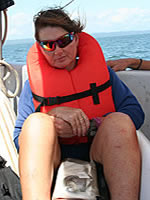
holding the "Nei-Kuan"
nausea
acupuncture
points on a Belize
to
Guatemala
boat crossing
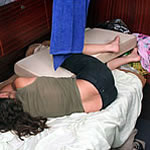
suffering from
seasickness is no fun at all
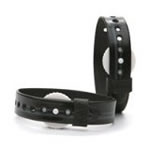
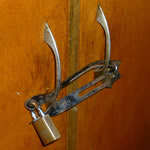
two rack extenders &
padlocks make
a
deterrent lock
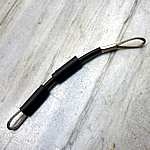
small steel wire rope
sling which doubles
as
a bike wheel lock
Hotel security
Many articles on travel security suggest putting your valuables in a hotel safe, which is fine if there is one. In our experience that luxoury doesn't come by very often.After our room at Hotel Casablanca in Flores, Guatemala was searched by staff, we felt we could never really leave anything behind anymore. Traipsing around a town with all your electronic valuables is not really an option either. So for a long period, one of us always stayed behind. This quite frankly became a real drag.
So, we decided to find a way to create a standard sort of cupboard handle lock.
The first lock is made is using two rack extenders like these from Jandd and two small padlocks. All of these we carry in our panniers anyway, so instead of just sitting there, they have been put to regular good use.
The other cable - which Aaldrik found lying on the road and romantically gave to me as a birthday present - is a double-eye steel wire rope sling. I bet not too many gals out there can say they received one of those as a gift from their husband. They can be found at industrial hardware stores or shops dealing in wire rope. They also make an excellent "quick clamp" lock for the back wheel on your bike if you want added security to locking your bike in public spaces.
Sure, what we came up with is definitely not full-proof. Inside thieves - and unless you leave your window wide open, they nearly always are staff - could unscrew door handles, enter from the back of the wardrobe or even use bolt cutters. But like a bike lock, something is better than nothing.
I'm still a firm believer than even the smallest deterrent might send a thief looking for an easier target.
I once owned, what I considered one of the most beautiful mountain bikes on this planet: a Kona Hot. I saved up all my money and in 1994, I became the proud owner of an emerald green beauty. But not for long. Even though I followed all the guidelines; even though I had the best locks (3) at the time; and even though it was in a well lit parking area with hundreds of other bikes, someone spotted her and she was gone forever.
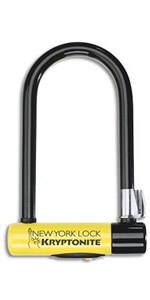
Kryptonite
New York
Standard Bicycle U-Lock
with Bracket
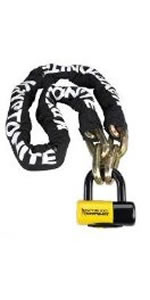
Kryptonite
New York Fahgettaboudit Chain
with Disc Lock
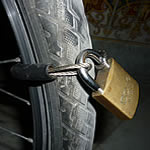
a steel wire sling is only a
deterrent
in public places.
It needs to be coupled
with
a decent lock or chain
We are travelling as a couple, so in public places and shops, one of us stays with the loaded bicycles. If our bikes can't be placed somewhere inside the hotel or guesthouse, then we don't stay there. The bikes are really old and look like they've been through the wars. If someone really wants to steal your bike, then they will do so no matter what or how many locks are used. The Rhodes Gorilla is a decent U-Bolt, though nowadays not high security. Still, it is a good deterrent and coupled with a solid wire we figure we have enough protection for what we need.
That said, some people travel with bikes of much greater value than ours or they are cycle touring alone. For them, good security is also peace of mind. I will mildly touch on the ins and outs of this bike safety subject to get you started, but the ultimate choice, well I'm afraid, that is entirely up to you. Besides, no matter what I say, it's your baby and you'll want do some research by yourself anyway.
Which
lock will best prevent
bicycle theft?
A good lock manufacturer
will stand by their product
so this will give you an
initial idea about how anti-theft
the product is. Kryptonite,
OnGuard and Masterlock all
offer protection plans on
their top of the range bicycle
locks. Another guide to choosing
the most suitable is to look
at their rating system. Then
check the reviews. Comments
from customers can be you
an indication of what is
good and bad with the product.
Generally U-locks are considered the best system for bike security and the most inferior is the cable or coil lock. Chains are also a good way of securing your bike, but for the sturdiest brands, you’ll be carting a lot of weight around with you. Still remember, any lock is better than no lock and two locks are better than one.
There is one other less prevalent type known as the O lock, like the Masterlock Street Cuffs and even though the company offers very good anti-theft protection there are mixed reviews.
Five brand leaders in bicycle security locks: Kryptonite | Onguard | Masterlock | Abus | Squire
Which bicycle lock will best suit me?So now that you are familiar
with the types of lock
available, you have to
make a choice and the following
issues you should think
about:
Where
will you be locking your bike up? High
risk or low theft areas. As a cycling
tourist, your bicycle is with you most
of the time. Solo tourer's have to consider leaving it
alone on more occassions.
How
easy is it to transport your
lock with you? A chain
or coil can often wrap
around the seat post
and a d-lock comes with
a holder. For cycle touring
though, the holder would
be in the way of precious
water bottle space, so
it is generally carried
in a bag or on the back
rack.
How
much weight are
you prepared to carry
with you?
Buy
hardened steel locks:
Unfortunately the
trade-off is usually: the
sturdier the heavier.
A
snug fitting lock is
advisable: leave
no room for levers
to get between the
post and your bike
Purchase
two locks instead
of one
Want to know even more about choosing
different bike locks:
REI
Expert Advice: How
to choose a bike lock
Bicyclesource:
simple, informative
and concise article
Consumersearch:
Bike lock comparison
between a couple
of leading brands
How
can I prevent bike theft?
And here are a couple of
tips and resources for
preventing your bike from
being stolen:
- Buy two locks, but if you only have one lock, then let it be a U-lock and don't forget to use it.
- Position your U-lock through the frame as well as the rear wheel. If your front wheel quick releases, then detach and secure with U-lock as well.
- Check that what you are locking your bike to something secure. Is the bike rack solid? Remember that traffic and street signs are not a secure spot to tie your bike up to. Poles can be removed as can the sign at the top.
- Lock your bike in a well lit area that can be viewed by the public.
- Paint over or remove quality brand names.
- Write down your serial number and scratch a personal code or id number in the frame somewhere.
- Don't leave your bike unattended overnight.
- Take a picture of it for reference if stolen.
- Secure any quick-release components either to your U-bolt or chain or take them with you.
A guide to bike security: an excellent brochure (in content and graphic form) from Bicycle Habitat
Lock Strategy by sheldon Brown
Theft-prevention-tips-for-bicycle-owner from Helen Smeaton.
A range of bike locks available at : REI | Amazon | Cyclo Camping

the rewards of cycle
touring certainly
outweigh
any risks
Is bicycle touring safe?
No matter what travel activity you undertake, you are going to be confronted with certain safety concerns. The stereotyped image portrayed by media or simply the unknown of any country can play havoc with our imaginations too. The result is you "umming and aahing" as to whether entering the perceived danger zone is a good idea or not.As far as we are both concerned, intrepid travel is always a good idea and if the country is not at war, then we say: "why not try it?" Most of your apprehensions will fade once you get there and you will be more than likely surprised by the warmth and hospitality of locals in a region of our world that sees little tourism, than in one that is overrun with it. So basically, don't let fear be a reason not to load up the bike and remember while following the well pedalled cycle route is sometimes unavoidable, it is not always the most rewarding touring.
A couple of points for cycle touring safety are discussed below, but it is a very personal issue.Your daring plays an important role in your day to day travel choices. Simply "feeling safe or comfortable" on your journey usually eliminates most of your travel fears as does gaining more on-the-road experience.
- trust your gut instincts: these will develop, the more you travel
- put yourself in situations that you feel comfortable with
- plan beforehand, but don't be scared to change the itinerary if things aren't working out
- check other cyclists blogs: use this information as a guide and not as gospel. For a selection of sites under one roof you can start with: go bicycle touring from Amaya & Eric or En-CYCLO-pedia from TravellingTwo or the links section on this site.
- do a bit of research on the country you are going to prior to cycling there
- if you are cycling into "so called" problem areas, have your wits about you and be on double alert
- post questions on bike forums:
Lonely Planet | Bike Forums | Cyclechat | CTC | Cyclo Camping | Wereldfietser (Dutch) - don't tell every local what you are doing or where you intend to spend the night, especially if wild camping.
- if it feels unsafe, move on
- carrying a defensive weapon is not really necessary and remember, if you are not trained in using it correctly or in times of stress, it could actually be used against you.
- don't abandon your route just because locals warn of danger. Takeheed, but in most cases it is hearsay. This is where your homework comes in handy. Check again to see if any cyclists have had recent problems.
- in big cities, keep a good watch out for your belongings and be "cycle" alert
Lastly, many people think you have to be incredibly fit to bicycle tour. This may not be entirely true. Probably the only criteria you will really need is a healthy mind, some common sense, a smile and inbuilt perseverance. These qualities will not only get you up the highest mountains and across scorching deserts, but they will allow you to look after yourself on your travels too. The more you cycle tour, the more natural it all becomes and it could, if you are not careful, develop into a way of life. For safety travel advice for women: see our travel tips for women page
No
Footprint travel - COMING SOON
Whether you are travelling on a bicycle
or by any other means there are ways for making
your travels eco-friendly.
Carrying little cloth shopping bags; battery
rechargers; solar panels; water filters and reusable
plastic bottles are only just the beginnng.
There are also ways to
help our planet while staying in a hotel or
camping wild.
In
the meantime take a look at:
Angela
Dollar's Top
ten tips for eco travel article.
With 14 years of traveling the globe and
as an employee of Crooked
Trails, Angela is well aware of the
effects of travel on local communities
and on the planet. Go
Green Travel Green: travel tips for the
eco-conscious traveller

solar enegy on wheels


